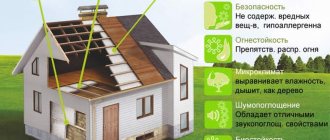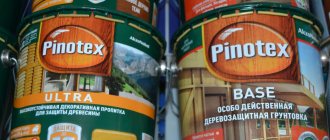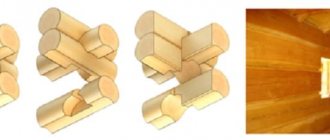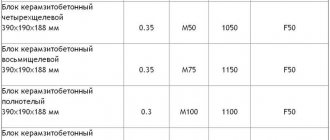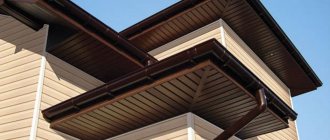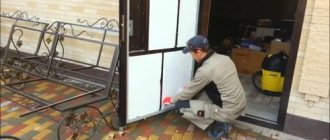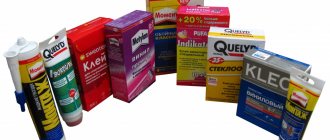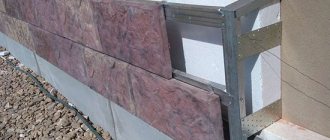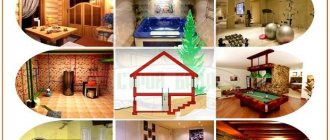The roof occupies a significant part of the area of the house, and naturally, if the structure is not insulated, then huge heat losses occur through it. All this is reflected in energy costs, which increase by at least 30%. An uninsulated roof is a potential source of dampness on the rafters, and as a result, fungus and mold on the ceiling. Therefore, insulating the roof of a wooden house is a vital measure, which, in addition to a comfortable stay, will provide great savings of money. In the article we will look at the features of thermal insulation of the roof, where it is better to do it: from the inside or outside of the house, what materials, and we will also provide detailed instructions on how to do this work with your own hands.
What to consider when insulating a roof
Whenever finishing work is carried out in a wooden house, you need to take into account the characteristics of this material. During the first year and a half after construction, the tree actively shrinks and the structure becomes deformed, so there can be no talk of any insulation during this period. We begin thermal insulation when shrinkage has ended.
If you plan to make the attic residential or place a storage room in it, then it is necessary to insulate the roof and the ceiling between it and the interior. If it will not be used as a residential building, it is allowed to insulate only the attic floor and the ceiling in the house.
When thermally insulating the roof of an old log house, a thorough inspection of the structure must be carried out before work. If the roof was leaking, there is probably mold, mildew, or rotten areas on the beams; they will have to be replaced.
When arranging an attic, it is recommended to combine thermal insulation with a special foil film. The reflective layer is fixed on the outside, so it will effectively reflect UV rays during active sun, and the attic will not heat up too much.
Materials for roof insulation
It is very important to choose high-quality and reliable material for thermal insulation of the roof of a timber house. There are a number of parameters that roof insulation must comply with.
Material requirements
Key indicators of a high-quality heat insulator:
- environmental friendliness and safety for humans.
- low thermal conductivity (no more than 0.04 W/m°C);
- light weight so as not to create additional load on the load-bearing elements of the structure;
- holds its shape well;
- high vapor permeability;
- soundproofing properties;
- density not lower than 15 kg/m3.
What insulation can be used for the roof
Types of roof insulation
It should be said that among the huge number of modern insulation materials, there are not many materials that meet the criteria listed above.
To insulate the roof you can use:
- mineral wool;
- ecowool;
- expanded clay;
- expanded polystyrene;
- polyurethane foam.
Features of each material
To determine which insulation is better, let’s look at each in more detail:
- Mineral wool is rightfully considered the best material for thermal insulation of a wooden house. With a low weight, it has a high density, which is very important when insulating a roof structure. Mineral wool is not flammable and does not absorb moisture; these indicators are especially valuable when used in wooden buildings. Resistance to high temperatures allows it to be used to insulate the roof of a bathhouse. The material is of natural origin, rodents do not like it, and insects do not grow in it.
- Ecowool. Made from cellulose, it is light weight and affordable. It is a good heat and sound insulator. But the material is highly flammable; to prevent ignition, fire retardants are added to the composition to prevent the spread of flame. It is not advisable to use in very damp areas.
- Expanded clay. Loose insulation consisting of hollow granules. Due to its porous structure it has high thermal insulation properties. For effective heat transfer, a thick layer of material is needed, which increases the load on the supporting structures.
- Expanded polystyrene. Presented in the form of slabs that are light weight, high strength, and have good thermal insulation abilities. The material is flammable, therefore, when insulating a log house, it is necessary to choose slabs with a flammability rating of G1.
- Polyurethane foam. Similar to the previous material, it is a light-weight, durable slab that is easy to install and lasts a long time. Spray insulation is also available for sale, but its installation requires professional equipment.
Choice of insulation
Today, the market offers a wide range of materials that can be used as roof insulation from the inside. If these are slopes, a layer of thermal insulation is laid between the rafters before the finishing coating, which is quite convenient. The question is what type of mineral wool to choose if there are several of them
To do this, it is important to familiarize yourself with their technical and operational characteristics, compare them, and analyze the advantages
You can start by studying glass wool, which has been in demand for many years. This material contains fiberglass, the thickness of which does not exceed 15 microns. Such products are offered in several formats - rolls, mats and slabs. As for the distinctive characteristics, glass wool has amazing thermal insulation properties, high fire resistance and resistance to biological pathogens. If you choose a slab material, make sure how easy installation will be. It’s safe to say that this is a budget insulation option that attracts many consumers.
Next on the list of thermal insulation materials was basalt or stone wool. This is a fibrous product that contains bentonite clay, carbonate and other composite ingredients. Such mineral wool is not capable of burning, it also has good thermal insulation properties, it is resistant to fungus and mold, which is an important advantage. As for the structure, it is not so strong, but the installation will be safe and easy, so the material attracts a lot of attention.
Thermal insulation methods
There are two ways to insulate a roof structure: from outside and from inside the room. External thermal insulation is carried out simultaneously with the installation of the roofing. Most often, the roof of the second floor is insulated from the inside; this method is less expensive and simpler. Below we will look at both options in more detail.
An important question that needs to be resolved before starting work: will the attic space be residential or not? If yes, then you will have to insulate the entire roof. In another case, it is enough to insulate the attic floors and the ceiling of the adjacent floor.
Final stage
Insulating the roof of a wooden house is completed by insulating the floor and ceiling of the attic, which will not allow the warm air rushing upward to collide with the flows of cold air descending from the uninsulated ceiling. The thermal insulation layer is arranged with waterproofing elements.
First, all the cracks between the beams and beams are filled with tow, felt, or foam insulation is used. Next, the space between the beams is filled with mineral wool, expanded clay and slag are laid on top. If the attic space is used for living space, then properly insulate the wooden floor, leaving a small gap between the boards and the insulation, which also helps reduce the formation of condensation.
Roof insulation technologies
Experts recommend thermal insulation of roof slopes using mineral wool or extruded polystyrene foam. Both materials do not support combustion, which is very important for wooden structures. Below we will look at how to properly insulate a roof using different methods and materials.
Thermal insulation with slabs or mats
Roof insulation technology
The insulation pie diagram looks like this:
- The rafter system is covered with waterproofing material. For this, it is best to use high-density polyethylene (more than 200 microns), which will protect the roof from precipitation and wind. The canvases are laid overlapping each other and secured to the rafters with staples.
- A counter-batten is attached to each wooden element on top of the film, which serves to form a ventilation gap between the waterproofing and the roof covering.
- If the slopes are covered with soft material, sheets of plywood are laid on top of the counter slats. When using slate, a sheathing is installed. The pitch between the slats depends on the length of the sheets of roofing material.
- The roof covering is being laid.
Thermal insulation with slabs
All the described measures were carried out within the framework of external insulation. Next, you can begin to insulate the roof inside the house.
- Insulating material is placed in the space between the rafters, the thickness of which should match the width of the beams. It should fit tightly to the structural elements, leaving no gaps. Installation begins from the bottom, gradually moving towards the ridge.
- The insulation is covered with a vapor barrier film, which is attached to the rafters with slats.
- If you intend to equip a residential attic, the surface is sheathed with plasterboard or clapboard.
If necessary, for example in harsh climatic conditions, you can make a thicker insulation cake:
- The first layer of insulation, corresponding in thickness to the width of the rafters, is laid between the beams.
- Cross slats are placed on the beams in increments equal to the width of the next layer of insulation. You don't need thick material here; you can take thinner slabs.
- A vapor barrier layer is laid over the thermal insulation, the film is attached to the slats using a stapler.
- Decorative finishing material is mounted to the slats.
Insulation with sprayed polyurethane foam
This method can be used both when it is intended to organize a living room in the attic, and for an ordinary attic.
In the first case, it is necessary to insulate both attic floors and roof slopes. Before work, wooden elements must be moistened. This is done for better adhesion of the sprayed material to the surface.
Polyurethane foam is sprayed in a thin layer onto the damp surface between the beams. After the material has hardened, you can apply another layer if necessary. Spraying is carried out from the bottom up; the lower layers, when hardened, will serve as a support for the next levels.
Polyurethane foam insulation creates a completely sealed, moisture-resistant coating that has excellent thermal insulation characteristics. The service life of the material is about thirty years, during which the insulation remains unchanged and does not lose its original properties.
Insulating the roof of a log house is not an easy job; doing it yourself, without experience and special knowledge, is quite difficult. By deciding to do the insulation yourself, the home owner risks getting a poor-quality result, which will then have to be corrected by professionals. Therefore, it is better not to experiment, but to immediately contact specialists.
is ready to provide professional services in Moscow and the region for insulating the roofs of wooden houses. We use proven technologies and high-quality materials, which guarantees excellent results.
You can get additional information and call a specialist for free to take measurements on the “Contacts” page.
Calculate the cost of painting and insulating your home right now
Select types of work:
Select materials:
Useful tips
To implement high-quality, reliable and durable vapor barrier, it is necessary to adhere not only to the relevant stages of installation and installation, but also to the operating and safety rules:
When choosing a product, as well as during its transportation, it is important to pay attention to the integrity of the packaging. All movements must occur carefully: shocks and mechanical damage, leading to deformation and a decrease in the quality of the product, should not be allowed. Outdoor storage is not allowed, since any precipitation can also affect the structure of the material. If the product will be located outside before starting work, any reliable padding must be placed under it, and covered with a tarpaulin or cellophane on top.
- It is advisable to keep the rolls in an upright position in a dry place with a flat surface. On the street you can place the packages under a canopy.
- Don’t forget about safety when working with the canvas. For this, a respirator is used, and gloves are used to protect hands. You can cut the material with a knife specially designed for cotton wool.
Rockwool vapor barrier is a reliable and durable vapor barrier that makes it possible to forget for a long time about the discomfort that arises from dampness and cold. The main thing is to correctly install the film.
To learn how to insulate an attic with Rockwool film, see the following video

